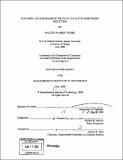| dc.contributor.advisor | Richard R. Schrock. | en_US |
| dc.contributor.author | Weare, Walter Warren | en_US |
| dc.contributor.other | Massachusetts Institute of Technology. Dept. of Chemistry. | en_US |
| dc.date.accessioned | 2007-02-21T13:16:37Z | |
| dc.date.available | 2007-02-21T13:16:37Z | |
| dc.date.copyright | 2006 | en_US |
| dc.date.issued | 2006 | en_US |
| dc.identifier.uri | http://hdl.handle.net/1721.1/36259 | |
| dc.description | Thesis (Ph. D.)--Massachusetts Institute of Technology, Dept. of Chemistry, 2006. | en_US |
| dc.description | Vita. | en_US |
| dc.description | Includes bibliographical references. | en_US |
| dc.description.abstract | The dinitrogen reduction capability of a series of new triamidoamine based molybdenum compounds has been studied. The synthesis of a number of different triamidoamine ligands, and their resulting molybdenum compounds, is described. While symmetric variants containing electron-withdrawing hexaisopropyl terphenyl substituents can successfully catalyze dinitrogen reduction to ammonia, only the most bulky unsymmetric "hybrid" compounds can facilitate this reaction. Further study of these systems reveals a different pathway for catalyst failure than had previously been observed. It was discovered that, at least for the smaller ligands, a base-catalyzed hydrogenase reaction occurs at a rate much faster than that of ammonia formation. The Mo(IV) diazenido (LMoN2H) compound undergoes net H. loss, forming the Mo(III) dinitrogen (LMoN2) species with concomitant release of H2. Examination of the "parent" system has also revealed previously unknown intricacies of the dinitrogen reduction reaction. By developing a means to measure H2 formation, we are now able to fully quantify the reducing equivalents added to our system. | en_US |
| dc.description.abstract | (cont.) This supports our belief that only NH3 and H2 are formed during catalysis. In addition, control experiments demonstrate that the proton source typically utilized for catalytic study, [2,6-lutidinium][BAr4'], can be reductively coupled under catalytic conditions. Therefore an acid that avoids this coupling reaction ([2,4,6-collidinium][BAr4']) is now utilized during most catalytic experiments. | en_US |
| dc.description.statementofresponsibility | by Walter Warren Weare. | en_US |
| dc.format.extent | 138 leaves | en_US |
| dc.language.iso | eng | en_US |
| dc.publisher | Massachusetts Institute of Technology | en_US |
| dc.rights | M.I.T. theses are protected by copyright. They may be viewed from this source for any purpose, but reproduction or distribution in any format is prohibited without written permission. See provided URL for inquiries about permission. | en_US |
| dc.rights.uri | http://dspace.mit.edu/handle/1721.1/7582 | |
| dc.subject | Chemistry. | en_US |
| dc.title | Synthetic and mechanistic study of catalytic dintrogen reduction | en_US |
| dc.type | Thesis | en_US |
| dc.description.degree | Ph.D. | en_US |
| dc.contributor.department | Massachusetts Institute of Technology. Department of Chemistry | |
| dc.identifier.oclc | 77281794 | en_US |
